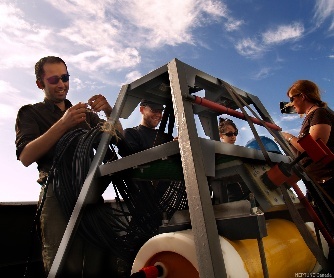Controlled-Source Electromagnetic System (CSEM)
The CSEM Project
At ODP 889 Gas hydrates increase the resistivity and stiffness of marine sediment. The CSEM is a stationary imaging experiments that generates data sensitive to changes in these properties. Using the NEPTUNE Regional Network, the CSEM provides continuous, real-time monitoring of the gas hydrate-associated, "Bullseye" cold vent offshore Vancouver Island.
The CSEM sends a precise electromagnetic signal from a transmitter (TX) dipole on the seafloor which is recorded at several seafloor receiver (RX) dipoles located at a range of distances from the transmitter. The data are sensitive to subtle changes in resistivity of the sediment between the TX and RXs. The difference is due to the displacement of conductive pore water by electrically-insulating gas hydrate.
Repeated soundings of the CSEM at Bullseye, over the lifetime of the Neptune project, will track changes in resistivity and reveal the evolution of the gas hydrate deposit. The CSEM method used is described theoretically by Edwards (1997) and experimentally by Schwalenberg et al (2005).
CSEM Deployment
The CSEM equipment consists of a transmitter, affixed to a small instrument platform, and a string of 5 receivers, spaced 200m apart along a 1km cable. During installation, the cable and receivers were spooled onto a drum, which was connected to ROCLS. Both of these payloads were lowered by winch from the deck of the R/V Thompson to the seafloor.
The CSEM deployment involved two ROPOS dives and two equipment drops using the ship's winch. The man of the hour during all of this was University of Toronto doctoral candidate Reza Mir, who joined the installation cruise to help coordinate and oversee installation.
Once the ROCLS spool and the transmitter platform were placed on the seafloor, ROPOS flew down, attached to ROCLS, laid the 1km reciever string and recovered ROCLS to the ship. In the following dive, ROPOS again located the transmitter platform, arranged two heavy dipoles on the seafloor nearby, connected it to the receiver string and connected the ODP 889 instrument platform to the CSEM platform.
CSEM on deck. Click to enlarge photo.
